Assessing Green Strategies for Urban Cooling in the Development of Nusantara Capital City, Indonesia
Abstract
1. Introduction
2. Materials and Methods
2.1. Study Area
2.2. Masterplan of Nusantara Capital City
2.3. Land Use and Land Cover Scenarios
2.4. WRF-UCM
2.5. Numerical Experiment Setup
2.6. Mitigation Scenarios
3. Results and Discussion
3.1. Model Validation
3.2. Effect of LULC on Land Surface Temperature
3.3. Cross-Sectional Winds and Temperature Profile
3.4. Land Surface Temperature Comparison
3.5. Effects of the Water Body
4. Conclusions
- The cooling effects in built-up areas vary significantly across different scenarios. Scenarios 2, 5, and 6, which incorporate LULC with blue–green infrastructure, exhibit the most substantial reductions in surface air temperature because of their ability to mitigate UHI effects. Conversely, scenarios 3 and 4, which feature grasslands and mixed forest LULC, show the least cooling effects and, in some cases, even higher air temperatures and wind speeds than scenarios without blue–green infrastructure. As noted earlier, mitigation measures were also incorporated into scenarios 2–6 by modifying the albedo values of urban areas to 0.8 for roofs and 0.7 for walls.
- The study further highlights that, in the case of Nusantara, mixed forests are generally more effective than grasslands in mitigating adverse urban microclimatic impacts. Mixed forests provide better cooling effects because of their greater evapotranspiration capacity, which is driven by greater leaf area and vegetation density. The tree canopy in mixed forests offers significant shading, which reduces surface temperatures, whereas grasslands, with minimal shading, contribute less to cooling. Additionally, grasslands, which are characterized by low-lying vegetation, absorb and release heat differently, limiting their ability to buffer temperature fluctuations compared with the vertical structure of forests.
- Among all the LULC scenarios, scenario 5, which included the highest proportion of blue–green spaces (65%), exhibited the most significant urban cooling effect. This scenario has the potential to reduce the average surface air temperature by approximately 2 °C, outperforming the other scenarios.
- The simulation results for scenario 2 show that wind passing over a water body before entering EBF areas provides an additional cooling effect of approximately 2.4 °C. This cooling effect further propagates as the air moves from built-up areas into other land types. These findings underscore the critical role of strategically integrating water bodies and blue–green spaces into urban planning to enhance natural cooling and alleviate urban heat, especially in densely developed areas.
Author Contributions
Funding
Data Availability Statement
Acknowledgments
Conflicts of Interest
Appendix A



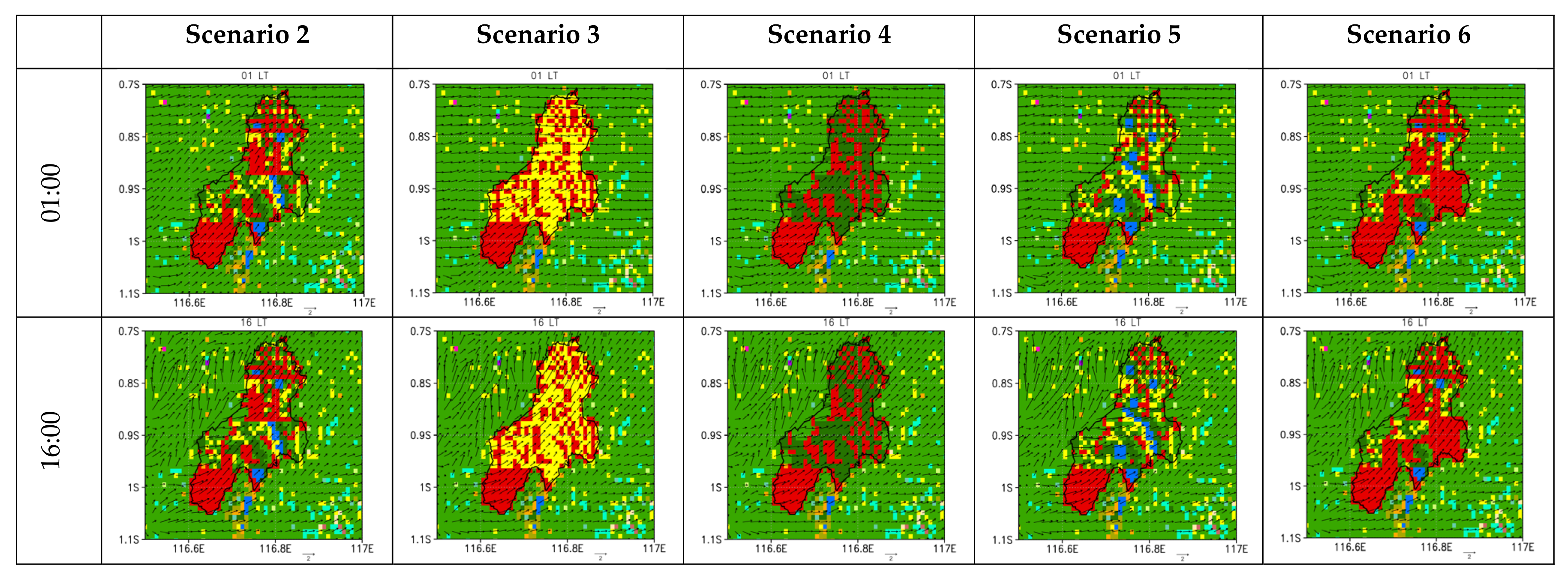
References
- Elmqvist, T.; Fragkias, M.; Goodness, J.; Güneralp, B.; Marcotullio, P.J.; McDonald, R.I.; Parnell, S.; Schewenius, M.; Sendstad, M.; Seto, K.C.; et al. Urbanization, Biodiversity and Ecosystem Services: Challenges and Opportunities: A Global Assessment; Springer: Dordrecht, The Netherlands, 2013; pp. 1–755. [Google Scholar] [CrossRef]
- Bhanage, V.; Kulkarni, S.; Sharma, R.; Lee, H.S.; Gedam, S. Enumerating and Modelling the Seasonal alterations of Surface Urban Heat and Cool Island: A Case Study over Indian Cities. Urban Sci. 2023, 7, 38. [Google Scholar] [CrossRef]
- Bhati, S.; Mohan, M. WRF model evaluation for the urban heat island assessment under varying land use/land cover and reference site conditions. Theor. Appl. Clim. 2016, 126, 385–400. [Google Scholar] [CrossRef]
- Doan, Q.; Kusaka, H. Numerical study on regional climate change due to the rapid urbanization of greater Ho Chi Minh City’s metropolitan area over the past 20 years. Int. J. Clim. 2016, 36, 3633–3650. [Google Scholar] [CrossRef]
- Dwivedi, A. Macro- and micro-level studies using Urban Heat Islands to simulate effects of greening, building materials and other mitigating factors in Mumbai city. Arch. Sci. Rev. 2019, 62, 126–144. [Google Scholar] [CrossRef]
- Dwivedi, A.; Khire, M. Application of split- window algorithm to study Urban Heat Island effect in Mumbai through land surface temperature approach. Sustain. Cities Soc. 2018, 41, 865–877. [Google Scholar] [CrossRef]
- Dwivedi, A.; Mohan, B.K. Impact of green roof on micro climate to reduce Urban Heat Island. Remote. Sens. Appl. Soc. Environ. 2018, 10, 56–69. [Google Scholar] [CrossRef]
- Al Kafy, A.; Faisal, A.A.; Rahman, S.; Islam, M.; Al Rakib, A.; Islam, A.; Khan, H.H.; Sikdar, S.; Sarker, H.S.; Mawa, J.; et al. Prediction of seasonal urban thermal field variance index using machine learning algorithms in Cumilla, Bangladesh. Sustain. Cities Soc. 2021, 64, 102542. [Google Scholar] [CrossRef]
- Kant, Y.; Bharath, B.D.; Mallick, J.; Atzberger, C.; Kerle, N. Satellite-based analysis of the role of land use/land cover and vegetation density on surface temperature regime of Delhi, India. J. Indian Soc. Remote Sens. 2009, 37, 201–214. [Google Scholar] [CrossRef]
- Demisse Negesse, M.; Hishe, S.; Getahun, K. LULC dynamics and the effects of urban green spaces in cooling and mitigating micro-climate change and urban heat island effects: A case study in Addis Ababa City, Ethiopia. J. Water Clim. Change 2024, 15, 3033–3055. [Google Scholar] [CrossRef]
- Uddin, A.S.M.S.; Khan, N.; Islam, A.R.M.T.; Kamruzzaman, M.; Shahid, S. Changes in urbanization and urban heat island effect in Dhaka city. Theor. Appl. Clim. 2022, 147, 891–907. [Google Scholar] [CrossRef]
- Mensah, C.; Atayi, J.; Kabo-Bah, A.T.; Švik, M.; Acheampong, D.; Kyere-Boateng, R.; Prempeh, N.A.; Marek, M.V. Impact of urban land cover change on the garden city status and land surface temperature of Kumasi. Cogent Environ. Sci. 2020, 6, 1787738. [Google Scholar] [CrossRef]
- Hassan, T.; Zhang, J.; Prodhan, F.A.; Sharma, T.P.P.; Bashir, B. Surface Urban Heat Islands Dynamics in Response to LULC and Vegetation across South Asia (2000–2019). Remote. Sens. 2021, 13, 3177. [Google Scholar] [CrossRef]
- Shi, Z.; Li, X.; Hu, T.; Yuan, B.; Yin, P.; Jiang, D. Modeling the intensity of surface urban heat island based on the impervious surface area. Urban Clim. 2023, 49, 101529. [Google Scholar] [CrossRef]
- Weng, Q.; Rajasekar, U.; Hu, X. Modeling urban heat islands and their relationship with impervious surface and vegetation abundance by using ASTER images. IEEE Trans. Geosci. Remote Sens. 2011, 49, 4080–4089. [Google Scholar] [CrossRef]
- Yuan, F.; Bauer, M.E. Comparison of impervious surface area and normalized difference vegetation index as indicators of surface urban heat island effects in Landsat imagery. Remote Sens. Environ. 2007, 106, 375–386. [Google Scholar] [CrossRef]
- Ahmed, H.A.; Singh, S.K.; Kumar, M.; Maina, M.S.; Dzwairo, R.; Lal, D. Impact of urbanization and land cover change on urban climate: Case study of Nigeria. Urban Clim. 2020, 32, 100600. [Google Scholar] [CrossRef]
- Heaviside, C.; Vardoulakis, S.; Cai, X.-M. Attribution of mortality to the urban heat island during heatwaves in the West Midlands, UK. Environ. Health A Glob. Access Sci. Source 2016, 15 (Suppl. S1), 49–59. [Google Scholar] [CrossRef]
- Yang, J.; Santamouris, M. Urban Heat Island and Mitigation Technologies in Asian and Australian Cities—Impact and Mitigation. Urban Sci. 2018, 2, 74. [Google Scholar] [CrossRef]
- Feizizadeh, B.; Blaschke, T. Examining Urban Heat Island Relations to Land Use and Air Pollution: Multiple Endmember Spectral Mixture Analysis for Thermal Remote Sensing. IEEE J. Sel. Top. Appl. Earth Obs. Remote. Sens. 2013, 6, 1749–1756. [Google Scholar] [CrossRef]
- Sarrat, C.; Lemonsu, A.; Masson, V.; Guédalia, D. Impact of urban heat island on regional atmospheric pollution. Atmos. Environ. 2006, 40, 1743–1758. [Google Scholar] [CrossRef]
- Li, H.; Harvey, J.T.; Holland, T.J.; Kayhanian, M. Corrigendum: The use of reflective and permeable pavements as a potential practice for heat island mitigation and stormwater management. Environ. Res. Lett. 2013, 8, 049501. [Google Scholar] [CrossRef]
- Gasparrini, A.; Guo, Y.; Hashizume, M.; Lavigne, E.; Zanobetti, A.; Schwartz, J.; Tobias, A.; Tong, S.; Rocklöv, J.; Forsberg, B.; et al. Mortality risk attributable to high and low ambient temperature: A multicountry observational study. Lancet 2015, 386, 369–375. [Google Scholar] [CrossRef] [PubMed]
- Lestari, S.; Syamsudin, F.; Pianto, T.A.; Sulistyowati, R.; Yulihastin, E.; Nugroho, D.; Hatmaja, R.B.; Amrina, D.; Habibi, M.N. Comparison of Statistical Properties of Rainfall Extremes Between Megacity Jakarta and New Capital City Nusantara. Springer Proc. Phys. 2023, 290, 325–334. [Google Scholar] [CrossRef]
- Ramadhan, R.; Marzuki, M.; Suryanto, W.; Sholihun, S.; Yusnaini, H.; Muharsyah, R.; Hanif, M. Trends in rainfall and hydrometeorological disasters in new capital city of Indonesia from long-term satellite-based precipitation products. Remote. Sens. Appl. Soc. Environ. 2022, 28, 100827. [Google Scholar] [CrossRef]
- Purwaningsih, A.; Lubis, S.W.; Hermawan, E.; Andarini, D.F.; Harjana, T.; Ratri, D.N.; Ridho, A.; Risyanto; Sujalu, A.P. Moisture Origin and Transport for Extreme Precipitation over Indonesia’s New Capital City, Nusantara in August 2021. Atmosphere 2022, 13, 1391. [Google Scholar] [CrossRef]
- Sofan, P.; Rahmi, K.I.N.; Sari, N.M.; Nugroho, J.T.; Wati, T.; Sakti, A.D. Modeling the Surface Thermal Discomfort Index (STDI) in a Tropical Environments using Multi Sensors: A Case Study of East Kalimantan, The Future New Capital City of Indonesia. J. Indian Soc. Remote. Sens. 2024, 52, 1761–1776. [Google Scholar] [CrossRef]
- Tursilowati, L.; Sunarya, R.; Muzirwan; Maryadi, E.; Susanti, I.; Rahayu, S.A. Seasonal Urban Heat Island Observation Using Remote Sensing and Google Earth Engine in the New Capital of Indonesia. J. Southwest Jiaotong Univ. 2023, 58, 1200–1218. [Google Scholar] [CrossRef]
- Denryanto, R.A.F.; Virgianto, R.H. The impact of land cover changes on temperature parameters in new capital of Indonesia (IKN). IOP Conf. Ser. Earth Environ. Sci. 2021, 893, 012033. [Google Scholar] [CrossRef]
- Sen, S.; Roesler, J.; Ruddell, B.; Middel, A. Cool Pavement Strategies for Urban Heat Island Mitigation in Suburban Phoenix, Arizona. Sustainability 2019, 11, 4452. [Google Scholar] [CrossRef]
- Marando, F.; Heris, M.P.; Zulian, G.; Udías, A.; Mentaschi, L.; Chrysoulakis, N.; Parastatidis, D.; Maes, J. Urban heat island mitigation by green infrastructure in European Functional Urban Areas. Sustain. Cities Soc. 2022, 77, 103564. [Google Scholar] [CrossRef]
- Kubota, T.; Lee, H.S.; Trihamdani, A.R.; Phuong, T.T.T.; Tanaka, T.; Matsuo, K. Impacts of land use changes from the Hanoi Master Plan 2030 on urban heat islands: Part 1. Cooling effects of proposed green strategies. Sustain. Cities Soc. 2017, 32, 295–317. [Google Scholar] [CrossRef]
- Vinayak, B.; Lee, H.S.; Gedam, S.; Latha, R. Impacts of future urbanization on urban microclimate and thermal comfort over the Mumbai metropolitan region, India. Sustain. Cities Soc. 2022, 79, 103703. [Google Scholar] [CrossRef]
- Pradana, R.P. Impacts of the Asian Australian Monsoon and Indo Pacific Sea Surface Temperature on Urban Climates in Major Indonesian Cities for Low Carbon Building Design. Adv. Hydrol. Meteorol. 2024, 1, 1–5. [Google Scholar] [CrossRef]
- Sulla-menashe, D.; Friedl, M.A. User Guide to Collection 6 MODIS Land Cover (MCD12Q1 and MCD12C1) Product. No. Figure 1; Usgs: Reston, VA, USA, 2018; pp. 1–18. [Google Scholar]
- Berawi, M.A. City of Tomorrow: The New Capital City of Indonesia. Int. J. Technol. 2022, 13, 690–694. [Google Scholar] [CrossRef]
- Hong, S.; Lim, J. The WRF single-moment 6-class microphysics scheme (WSM6). J. Korean Meteorol. Soc. 2006, 42, 129–151. [Google Scholar]
- Nakanishi, M.; Niino, H. An Improved Mellor-Yamada Level-3 Model: Its Numerical Stability and Application to a Regional Prediction of Advection Fog. Bound.-Layer Meteorol. 2006, 119, 397–407. [Google Scholar] [CrossRef]
- Zhang, C.; Wang, Y. Projected Future Changes of Tropical Cyclone Activity over the Western North and South Pacific in a 20-km-Mesh Regional Climate Model. J. Clim. 2017, 30, 5923–5941. [Google Scholar] [CrossRef]
- Iacono, M.J.; Delamere, J.S.; Mlawer, E.J.; Shephard, M.W.; Clough, S.A.; Collins, W.D. Radiative forcing by long-lived greenhouse gases: Calculations with the AER radiative transfer models. J. Geophys. Res. Atmos. 2008, 113, 2–9. [Google Scholar] [CrossRef]
- Tewari, M.; Chen, F.; Kusaka, H.; Miao, S. Coupled WRF/Unified Noah/Urban-Canopy Modeling System. NCAR WRF Doc. 2007; pp. 1–20. Available online: http://www.ral.ucar.edu/research/land/technology/urban/WRF-LSM-Urban.pdf (accessed on 20 September 2024).
- Paulson, C.A. The mathematical representation of wind speed and temperature profiles in the unstable atmospheric surface layer. J. Appl. Meteorol. 1970, 9, 857–861. [Google Scholar] [CrossRef]
- Chen, F.; Kusaka, H.; Bornstein, R.; Ching, J.; Grimmond, S.; Grossman-Clarke, S.; Loridan, T.; Manning, K.W.; Martilli, A.; Miao, S.; et al. The integrated WRF/urban modelling system: Development, evaluation, and applications to urban environmental problems. Int. J. Clim. 2011, 31, 273–288. [Google Scholar] [CrossRef]
- Chisale, S.W.; Lee, H.S.; Calvo, M.A.S.; Jeong, J.-S.; Aljber, M.; Williams, Z.; Cabrera, J.S. Advanced solar energy potential assessment in Malawi: Utilizing high-resolution WRF model and GIS to identify optimal sites for solar PV generation. Renew. Energy 2025, 239, 122084. [Google Scholar] [CrossRef]
- Ott, R.L.; Longnecker, M. An Introduction to Statistical Methods and Data Analysis, 6th ed.; Texas A&M University: College Station, TX, USA; Brooks/Cole: Pacific Grove, CA, USA, 2010; ISBN 13: 978-0-495-01758-5. [Google Scholar]
- Pallant, J. SPSS Survival Manual; Taylor & Francis: London, UK, 2020. [Google Scholar] [CrossRef]
- Tursilowati, L.; Sumantyo, J.T.S.; Kuze, H.; Adiningsih, E.S. The integrated WRF/Urban modeling system and its application to monitoring urban heat island in Jakarta-Indonesia. J. Urban Environ. Eng. 2012, 6, 1–9. [Google Scholar] [CrossRef][Green Version]
- Jankov, I.; Gallus, W.A.; Segal, M.; Shaw, B.; Koch, S.E. The Impact of Different WRF Model Physical Parameterizations and Their Interactions on Warm Season MCS Rainfall. Weather Forecast. 2005, 20, 1048–1060. [Google Scholar] [CrossRef]
- Crétat, J.; Pohl, B.; Richard, Y.; Drobinski, P. Uncertainties in simulating regional climate of Southern Africa: Sensitivity to physical parameterizations using WRF. Clim. Dyn. 2012, 38, 613–634. [Google Scholar] [CrossRef]
- Yang, B.; Qian, Y.; Lin, G.; Leung, R.; Zhang, Y. Some issues in uncertainty quantification and parameter tuning: A case study of convective parameterization scheme in the WRF regional climate model. Atmos. Meas. Tech. 2012, 12, 2409–2427. [Google Scholar] [CrossRef]
- Wang, Z.-H.; Bou-Zeid, E.; Au, S.K.; Smith, J.A. Analyzing the Sensitivity of WRF’s Single-Layer Urban Canopy Model to Parameter Uncertainty Using Advanced Monte Carlo Simulation. J. Appl. Meteorol. Clim. 2011, 50, 1795–1814. [Google Scholar] [CrossRef]
- Sanusi, R.; Jalil, M. Blue-Green infrastructure determines the microclimate mitigation potential targeted for urban cooling. IOP Conf. Ser. Earth Environ. Sci. 2020, 918, 012010. [Google Scholar] [CrossRef]
- Mitchell, G.; Chan, F.K.S.; Chen, W.Y.; Thadani, D.R.; Robinson, G.M.; Wang, Z.; Li, L.; Li, X.; Mullins, M.-T.; Chau, P.Y.K. Can green city branding support China’s Sponge City Programme? Blue-Green Syst. 2022, 4, 24–44. [Google Scholar] [CrossRef]
- Balany, F.; Ng, A.W.; Muttil, N.; Muthukumaran, S.; Wong, M.S. Green Infrastructure as an Urban Heat Island Mitigation Strategy—A Review. Water 2020, 12, 3577. [Google Scholar] [CrossRef]
- Kumar, P.; Debele, S.E.; Khalili, S.; Halios, C.H.; Sahani, J.; Aghamohammadi, N.; Andrade, M.d.F.; Athanassiadou, M.; Bhui, K.; Calvillo, N.; et al. Urban heat mitigation by green and blue infrastructure: Drivers, effectiveness, and future needs. Innovation 2024, 5, 100588. [Google Scholar] [CrossRef]


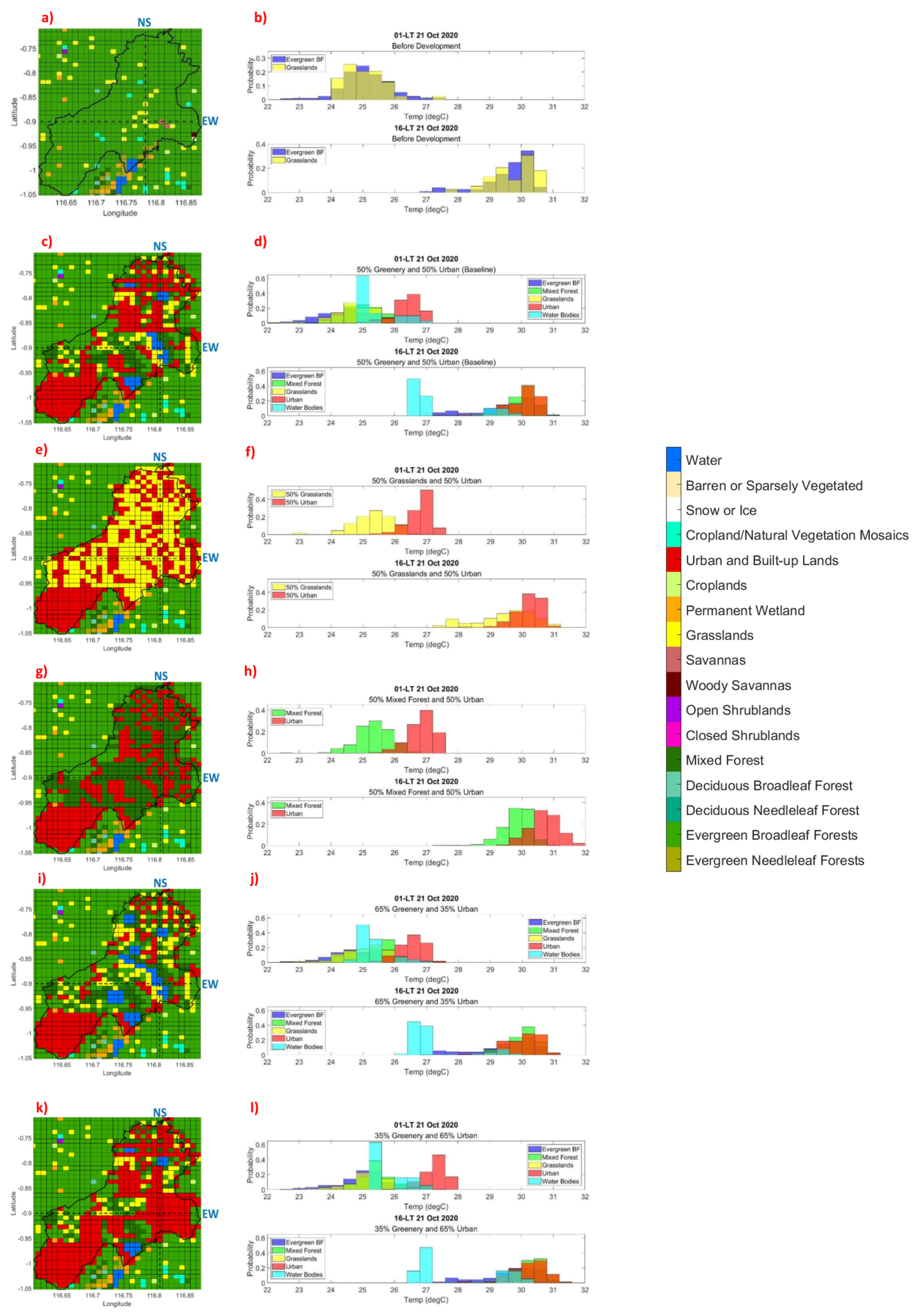
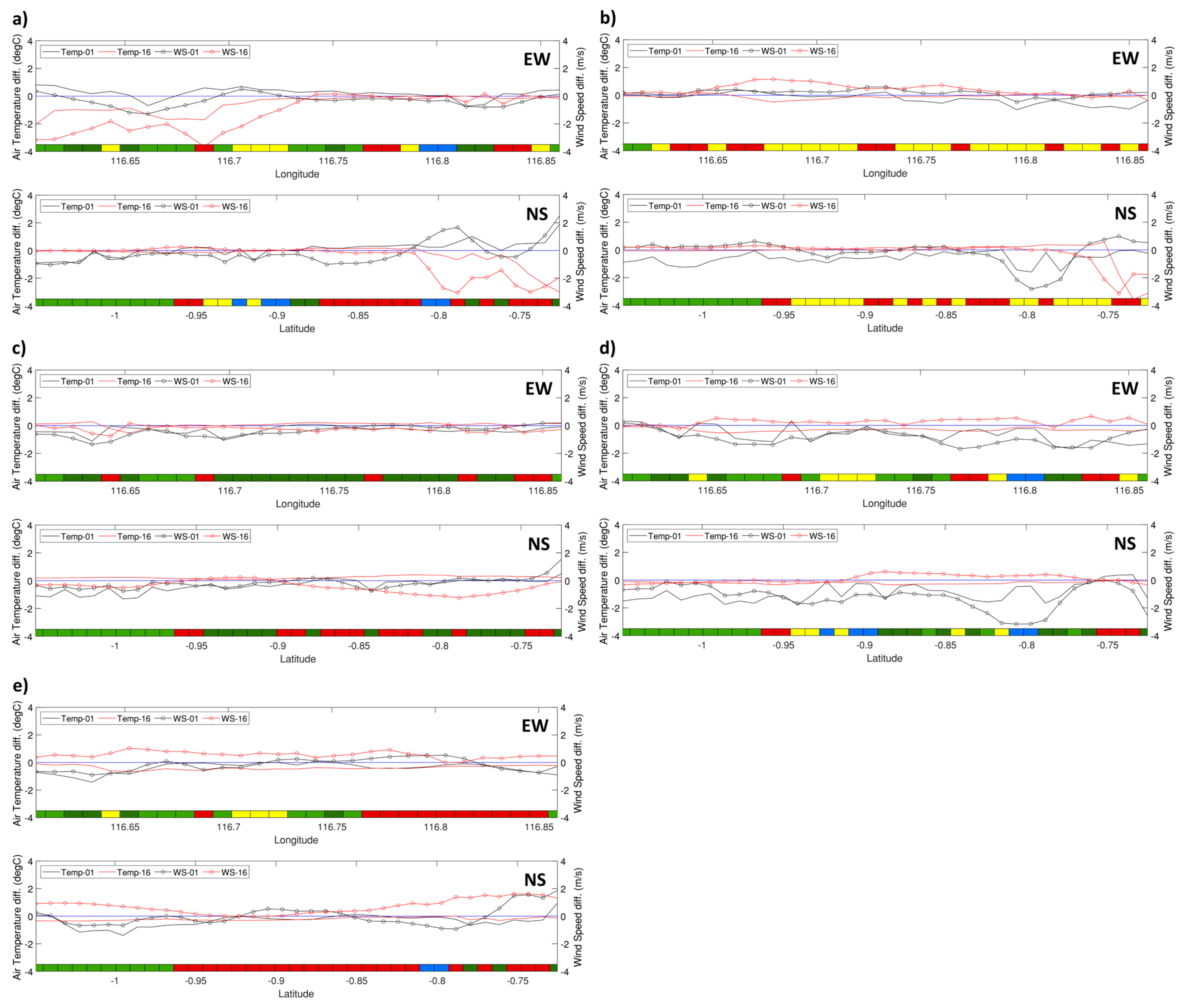
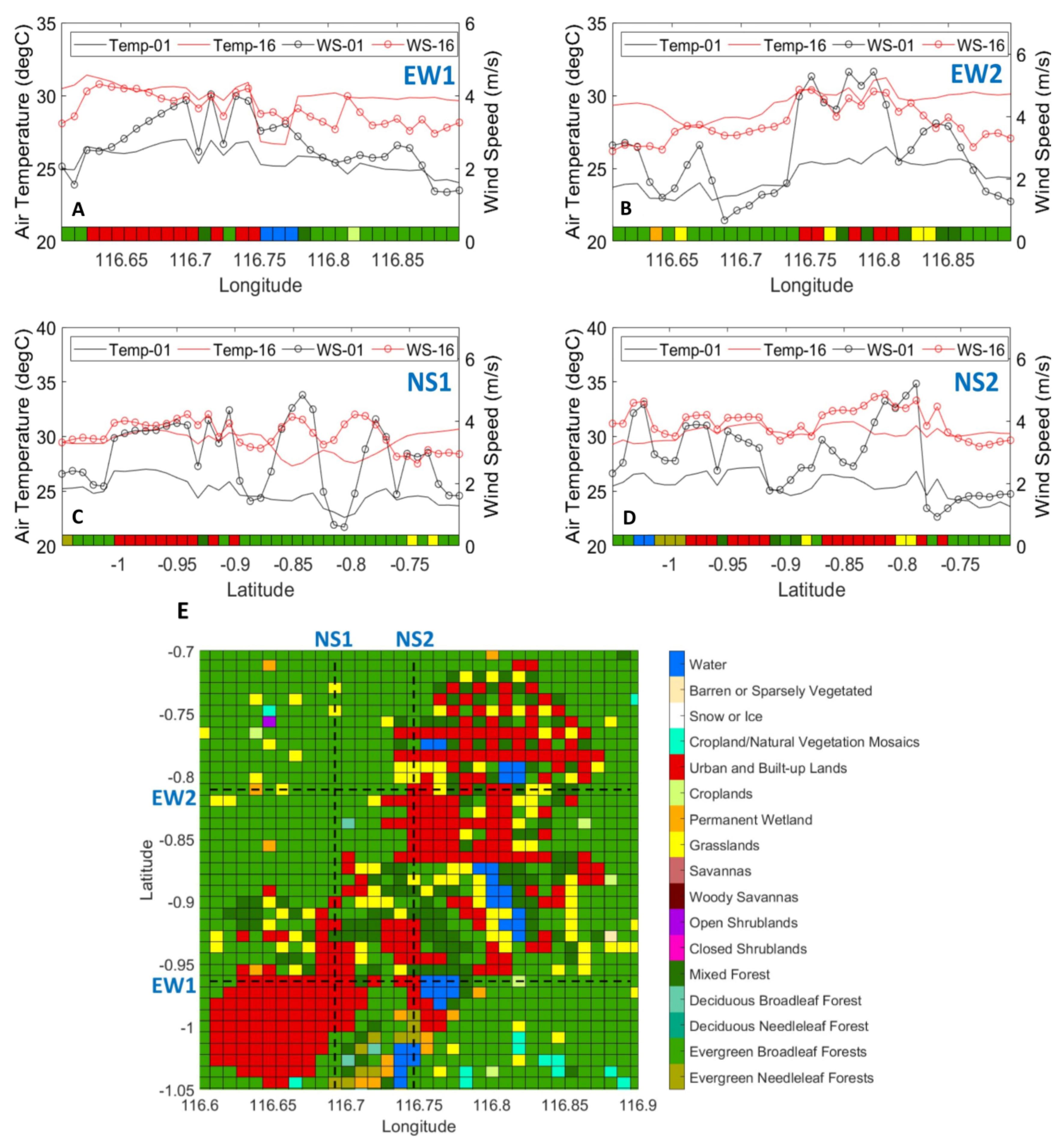
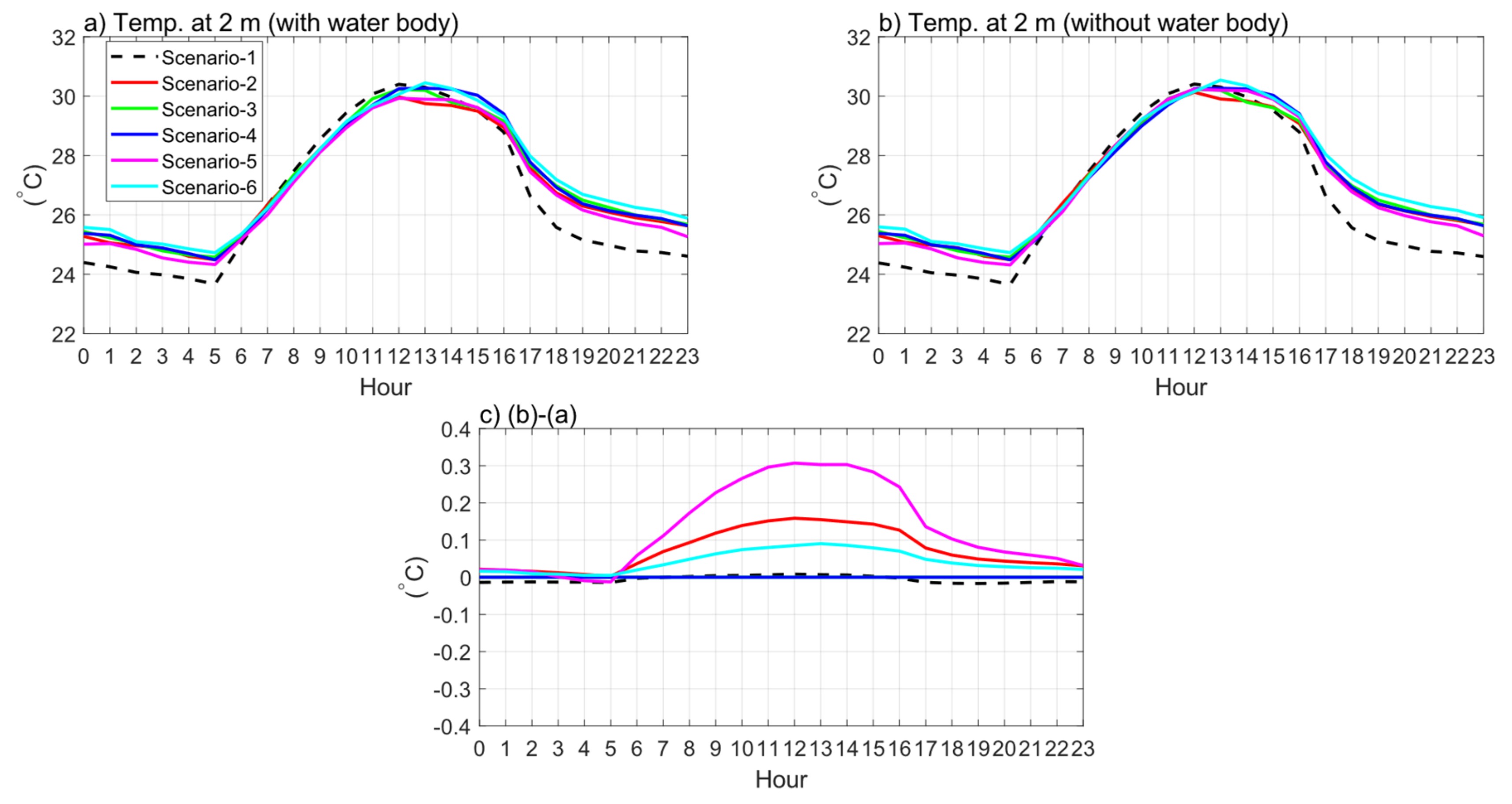
| No. | Class | Area Size (km2) | Percentage (%) |
|---|---|---|---|
| 1 | Water Bodies | 826 | 21.87 |
| 2 | Evergreen Broadleaf Forests | 914.25 | 24.21 |
| 3 | Closed Shrublands | 0.25 | 0.01 |
| 4 | Woody Savannas | 1642.75 | 43.49 |
| 5 | Savannas | 371.75 | 9.84 |
| 6 | Grasslands | 18 | 0.48 |
| 7 | Croplands | 0.5 | 0.01 |
| 8 | Urban and Built-up Lands | 3.5 | 0.09 |
| Total Area | 3777 | 100 | |
| Configuration | Domain 1 | Domain 2 | Domain 3 |
|---|---|---|---|
| Vertical level | 34 | 34 | 34 |
| Horizontal grid resolution | 25 km | 5 km | 1 km |
| Microphysics option | WSM6 | WSM6 | WSM6 |
| Planetary boundary layer | MYNN Level 2.5 | MYNN Level 2.5 | MYNN Level 2.5 |
| Cumulus scheme | New Tiedtke Scheme | New Tiedtke Scheme | New Tiedtke Scheme |
| Shortwave scheme | RRTMG | RRTMG | RRTMG |
| Longwave scheme | RRTMG | RRTMG | RRTMG |
| Land surface scheme | NOAH land surface model | NOAH land surface model | NOAH land surface model |
| Surface layer option | MM5 Similarity Scheme | MM5 Similarity Scheme | MM5 Similarity Scheme |
| Urban surface option | - | - | SL Urban Canopy Model |
| Building roofs albedo | - | - | 0.8 |
| Building wall albedo | - | - | 0.7 |
| Model Physics | Exp 1 | Exp 2 | Exp 3 | Exp 4 | Exp 5 | Exp 6 |
|---|---|---|---|---|---|---|
| Planetary Boundary Layer | YSU | YSU | MYJ | MYJ | YSU | MYNN 2.5 |
| Microphysics | WSM3 | WSM3 | WSM3 | Ferrier | WSM5 | WSM6 |
| Cumulus Scheme | Kain Fritsch (KF) | Moisture Advection: KF | Kain Fritsch | Kain Fritsch | Moisture Advection: KF | New Tiedtke Scheme |
| Statistical Indices | Values | |||||
| R2 | 0.41 | 0.43 | 0.41 | 0.39 | 0.46 | 0.50 |
| R | 0.64 | 0.65 | 0.64 | 0.63 | 0.68 | 0.71 |
| RMSE (°C) | 2.80 | 2.98 | 2.69 | 2.85 | 2.88 | 2.68 |
| Bias (°C) | −1.87 | −2.17 | −1.80 | −2.06 | −2.17 | −2.05 |
Disclaimer/Publisher’s Note: The statements, opinions and data contained in all publications are solely those of the individual author(s) and contributor(s) and not of MDPI and/or the editor(s). MDPI and/or the editor(s) disclaim responsibility for any injury to people or property resulting from any ideas, methods, instructions or products referred to in the content. |
© 2025 by the authors. Licensee MDPI, Basel, Switzerland. This article is an open access article distributed under the terms and conditions of the Creative Commons Attribution (CC BY) license (https://creativecommons.org/licenses/by/4.0/).
Share and Cite
Pradana, R.P.; Bhanage, V.; Fajary, F.R.; Hussainzada, W.; Badriana, M.R.; Lee, H.S.; Kubota, T.; Nimiya, H.; Putra, I.D.G.A. Assessing Green Strategies for Urban Cooling in the Development of Nusantara Capital City, Indonesia. Climate 2025, 13, 30. https://doi.org/10.3390/cli13020030
Pradana RP, Bhanage V, Fajary FR, Hussainzada W, Badriana MR, Lee HS, Kubota T, Nimiya H, Putra IDGA. Assessing Green Strategies for Urban Cooling in the Development of Nusantara Capital City, Indonesia. Climate. 2025; 13(2):30. https://doi.org/10.3390/cli13020030
Chicago/Turabian StylePradana, Radyan Putra, Vinayak Bhanage, Faiz Rohman Fajary, Wahidullah Hussainzada, Mochamad Riam Badriana, Han Soo Lee, Tetsu Kubota, Hideyo Nimiya, and I Dewa Gede Arya Putra. 2025. "Assessing Green Strategies for Urban Cooling in the Development of Nusantara Capital City, Indonesia" Climate 13, no. 2: 30. https://doi.org/10.3390/cli13020030
APA StylePradana, R. P., Bhanage, V., Fajary, F. R., Hussainzada, W., Badriana, M. R., Lee, H. S., Kubota, T., Nimiya, H., & Putra, I. D. G. A. (2025). Assessing Green Strategies for Urban Cooling in the Development of Nusantara Capital City, Indonesia. Climate, 13(2), 30. https://doi.org/10.3390/cli13020030









